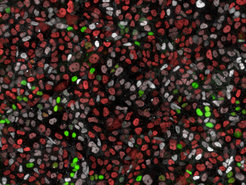Mice and men germ similarly and yet differently
Max Planck Researchers develop robust system for human germ cell development in the petridish
In order to reproduce and maintain a species, mammals have to produce eggs and sperm. Yet, not always do these germ cell types develop problem-free. To better investigate germ cell development and specification, it should be able to analyze the complete germ cycle – from the fertilized egg to mature oocytes and sperm – in the petridish. An in vitro-system would provide scientists with an ideal model not only to answer developmental, cellular and molecular biological questions, but also to investigate certain forms of infertility. So far, however, a method by which germ cells could be created in sufficient numbers for detailed analyses did not exist. Now, for the first time, scientists in the team of Professor Dr. Hans Schöler of the Max Planck Institute for Molecular Biomedicine in Münster have established a robust in vitro-system for early germ cell development with human pluripotent stem cells. By using this, they discovered many similarities with germ cell development in mice, but also important differences (EMBO Journal, online first, March 6th 2015).

Germ cell development in a petridish:
Gene products of the typical germ cell marker gene OCT4 (red), BLIMP1 (green) and BRACHYURY (white) were analyzed by fluorescence microscopy. About 5% of the cells in this culture are germ cell precursor cell that later on develop into germ cells.
